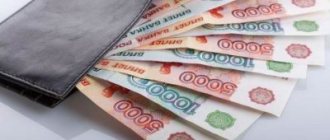Main types of apartments
Before we find out how “Brezhnevka” differs from “Khrushchevka” and “Stalinka”, let’s look at all the main types of apartments in Russia:
- Stalin's apartments. Living quarters in houses built during the reign of I.V. Stalin - in 1930-1940.
- "Khrushchevka". Apartments in brick or panel houses, massively built in 1950-1960.
- "Brezhnevki". Typical apartments in multi-storey buildings built in 1960-1980.
- "Improvements." Apartments with improved layout in buildings from the 1980s. They were distinguished by an increased area, separate bathroom, spacious kitchen and balconies (loggias); The house had a garbage chute and an elevator.
- Modern monolithic houses. Spacious, open-plan apartments with varying ceiling heights and strong and durable walls.
- Apartments in modern panel and block houses.
To understand how “Khrushchevka” differs from “Brezhnevka” or “Stalinka”, let’s briefly describe each group of apartments.
Old fund
These are buildings that have survived from the end of the 19th century and were erected before the 1940s. Their walls are usually brick or wood, and the ceilings and internal structures are also wooden. But modernization could also be carried out (replacing the floors with metal ones).
Main advantages: location close to the city center, thick external walls and original layouts: such houses usually have many small rooms, long corridors, and often the kitchen is a walk-through and has no windows. Elite houses of this type have luxurious entrances with spiral staircases.
There are many disadvantages, and most of them are related to the age of the buildings: worn out communications, the need for frequent and complex repairs. Often in such houses it is troublesome or even impossible to obtain permission for redevelopment. Old houses need to be chosen very carefully: carefully inspect the house from the basement to the roof, read the documentation, compare the image of the apartment on the plan with reality. It is good if the house has undergone renovation and a recent inspection. The “old fund” may be unreasonably expensive due to its location.
Stalin's houses are brick or ceramic block buildings built from the mid-30s to early 60s. There are a lot of options for “Stalin” guns - they can’t be called typical. The houses that were built for party workers look very presentable in appearance, have wide staircases, comfortable layouts with isolated large rooms and, most importantly, a spacious kitchen of 7-14 m². Their noise and heat insulation quality is often superior to new buildings.
Stalin buildings of a lower class, for workers, were often used as communal apartments: there are long corridors, small rooms, kitchens from 4.5 m².
Common advantages of all Stalin buildings: structural strength, high ceilings from 2.9 m, good layout. The other side of the coin: worn-out communications are the scourge of all old houses. However, if reconstructions were carried out with the replacement of communications, the house will last for a long time, and buying an apartment in it will be a good investment.
This is the first type of housing of mass construction from 1956 to 1985. “Even though it’s small, it’s our own”—this home became the first nest for many who were tired of living in public view in a communal apartment. At first, the Khrushchev buildings were brick, and later - panel ones. They are similar in appearance and have 5 floors (less often 4).
Apartments in brick Khrushchev buildings have an area of 22 m², a kitchen rarely larger than 4.5 m² and a combined bathroom. Rooms are 6–9 m², there are even rooms of 4 m² without windows. These undistinguished dimensions, low ceilings up to 2.6 meters and poor sound insulation currently result in the only advantage - low cost. These houses were designed for 25 years of service, but are still in use today, so even with a very limited budget, it is better to save up to buy something more reliable. At a minimum, it is worth carefully inspecting the house both inside and out, assessing its strength and quality of communications.
But even with all these shortcomings, brick Khrushchev buildings are better than panel ones. With similar areas, apartments of this type have huge heat losses due to the quality of the walls. It makes sense to buy such apartments only if they have been insulated.
Brezhnevki - panel houses made of concrete and expanded clay, 1960–1990. This is an improved version of the Khrushchev-era panel buildings with an increased number of floors (9 or 16 floors), although there are also five-story Brezhnevkas, which are very similar in appearance to the Khrushchev-era buildings. They began to install elevators and garbage chutes in these buildings, and increased the area of the apartments and the height of the ceilings to 2.70 m. The kitchen is 6–8 m², the bathroom is separate. The walls of Brezhnevka buildings are of better quality, but there are variations of this type of houses with very small apartments - gostinkas: the walls of such houses are no different from the panel Khrushchev houses.
This is interesting: Virtual Visa credit card for free
Brezhnevkas are better than Khrushchev panel buildings and are inexpensive, like all old panel houses, but it is still better to give preference to brick buildings or turn your attention to more modern housing. By the way, we will talk about it in the second part of this article.
"Stalin": space and high ceilings
Stalin's houses are, in a way, also beautiful creations in the spirit of neoclassicism, 2-5 floors high. The main material for them was brick (white, red), which was covered with plaster at the finishing stage. An interesting point: in the pre-war “Stalin” buildings, only the floors of the first floor and the ceiling of the last floor were concrete, and the interior floors were wooden. In post-war houses, all floors were made of reinforced concrete.
“Stalin” apartments are mainly multi-room apartments (3-4 rooms); one- and two-room apartments are very rare among them. The premises are distinguished by good square footage, spacious kitchens and hallways, rooms isolated from each other, and in some cases balconies. But most of all, “Stalin” buildings are valued for their ceiling height - 2.8-3.2 m.
Comparison
To understand the difference between Khrushchev and Stalin, let’s find out what the features of each type of house and the apartments located in them are.
Khrushchevka
Such houses were once built en masse in order to alleviate the situation with the housing shortage in the country. The goal was to spend the minimum amount of money. Among other things, it was decided not to install elevators in the houses. Therefore, the number of floors in Khrushchev is limited to five.
Residential buildings of this type were built quickly, since most often they had a panel construction. However, there are also brick buildings of this type. All Khrushchev buildings are united by a strict style. Their facades are made without any decorative design. Brick houses, as a rule, are not plastered.
The area of the Khrushchev apartments is small. There are usually two or one rooms in an apartment, less often three. In the kitchen and hallway you can't do much. Most projects have a combined bathroom. Mandatory amenities: central heating, water supply (usually only cold), sewerage. Khrushchev apartments are usually purchased for the first time by young families.
Stalinka
Such objects were intended to accommodate people of different statuses, so their exterior, interior design and amenities may be different.
Monumental brick buildings with ceremonial architecture, elevators and spacious entrances were erected for the elite of society: party leaders, valuable scientists, outstanding cultural workers. Apartments in such houses are as comfortable as possible, with a convenient layout and high (often above 3 m) ceilings. The rooms are wide and bright. The kitchen and hallway are also spacious. The bathroom is separate from the toilet.
The buildings were more modest, without much decoration, and were intended for ordinary residents. But, despite the lack of pomp, apartments in such buildings are also distinguished by good square footage and amenities.
There are also low-level Stalin buildings, built from brick or cinder blocks. Many of them were originally dormitories for workers. The area of apartments in such buildings is much smaller, there is often no bathroom, and several families may have one bathroom. By now, these Stalin buildings have become noticeably dilapidated, but some of them have undergone major renovations and now have amenities.
What is the difference between Khrushchev and Stalin in terms of cost? It should be noted here that Khrushchev is cheaper on average. High-order Stalins, despite their age, remain valuable, especially if they undergo good repairs.
"Khrushchevka": small, but its own
Continuing to talk about how “Khrushchevka” differs from “Brezhnevka”, we will analyze the characteristics of the premises built during the reign of Stalin’s successor. The motto of the construction of residential buildings, which started in 1955 according to the decree “On the development of housing construction in the Soviet Union,” was the slogan: “Each family has a small, but its own home!”
“Khrushchevka” are typical brick or panel houses of 3-5 floors, with low ceilings (2.5 m), without access amenities (elevator and toilet). Such buildings had no architectural value - they were built only to eliminate the housing shortage. One- and two-room apartments were characterized by poor sound insulation, the presence of adjacent non-insulated rooms, and a small combined bathroom.
Brief etymology and history of construction
The names, which carried too little information, were formed from an officially accepted phrase that characterized the time period by the name of the main leader of the Soviet Union.
The need to build new housing in its difficult history was dictated by various circumstances.
Stalinka
The main options for apartments of those times:
- Stalinka.
- Khrushchevka.
- Brezhnevka.
| Under Stalin - industrialization, the rapid growth of new cities, the construction of industrial giants that required a huge number of workers and housing to settle their owners. However, in houses built by Stalin, the ceiling height reached 3 meters, and space standards for each person and conditions for ventilation were taken into account. |
| The main differences (Stalinka, Brezhnevka or Khrushchevka) are not in the name of the series and not in the name of the leader who made the decision to design and start construction. In comparison with Stalin's, Khrushchev-type houses began to be built due to the enormous scale that industrial development had acquired. The need for living space after the Great Patriotic War was dictated by the consequences of enormous destruction. More than half of the entire housing stock was destroyed, and it had to be restored in a short time. |
| The housing problem, which became acute in the post-war years, required a new approach to its solution. In the construction of houses, functionalism, maximum economy, and the rejection of any architectural and planning excesses prevailed. The desire to save was dictated by the desire to quickly build the necessary meters and resettle people from communal apartments and barracks. It was assumed that providing each Soviet family with a separate apartment was a more pressing task than building houses with an increased level of comfort for some, while leaving others in buildings where it was almost impossible to live. |
| The new residents did not pay attention to the adjacent bathroom and the narrow, uncomfortable flights of stairs. The opportunity to move into separate housing and move the family there outweighed the stinginess of the layout, the design flaws, and the ceilings to the top. However, even when summing up all the shortcomings, the comparison between new buildings under Khrushchev, made of brick or blocks, and standard wooden ones with 2 floors, which belonged to the first Soviet mass series, was in favor of Khrushchev. |
| The name “Brezhnevka”, according to an already existing analogy, was derived from the surname of the then Secretary General Brezhnev. They are also classified as buildings in the style of functionalism, however, their difference, and quite significant, from Khrushchev is revealed not by an external inspection of the building, but by comparing the internal characteristics. Such apartments have been built since the mid-60s, but in the 80s the term “new layout” appeared. Despite the still existing housing shortage, improved apartment layouts became not only a need, but also an opportunity that the state had to offer. |
"Brezhnevki": improved high-rise buildings
The photo eloquently shows how “Khrushchevka” differs from “Brezhnevka”: the houses of the Leonid Ilyich era are already high-rise buildings with 5-14 floors. All of them were built, changed, modernized according to one document - the Unified Catalog of Construction Parts. “Brezhnevki” became in many ways the prototypes of modern comfortable new buildings. The layout of such apartments has significantly improved, garbage chutes and elevators have appeared in the entrances, and staircases and landings have become more spacious.
Inside the Brezhnev-era apartment you can already see a separate bathroom and toilet, waterproofing in the bathrooms, and a large area of the rooms. However, the same cramped kitchen, corridor and bathrooms remained. That's all, actually. Now you know the difference between “Khrushchev” and “Brezhnevka” in layout.
Briefly about Brezhnevka
The world has seen these types of houses since the early 1970s. At first they had 8 or 9 floors. After the 70s, one could already find 12 and 16-story Brezhnev buildings. The kitchens were enlarged (up to 7 m²), elevators and garbage chutes appeared. “Threshka rubles” and even 4-room apartments appeared. The bathroom and toilet are already separate, but still small.
This is interesting: Re-examination of the case on appeal
Clear benefits
Like everything else, the apartments listed above have their pros and cons. To have a complete understanding of the differences between a “Khrushchev” apartment and a “Brezhnevka” and “Stalin” apartment, let’s consider all their advantages:
- “Stalin” apartments: good location (in most cities such apartments are located in the center), spacious layout, high ceilings, excellent heat and sound insulation, large windows, isolated rooms, warm and dry brick houses, smooth walls and ceilings.
- “Khrushchevka”: affordability, location, if not in the center, then in an area with already fairly developed infrastructure.
- “Brezhnevki”: isolated rooms, good location in the city, the presence of an elevator and garbage chute, convenient layout, relative “youth” of the building, panel houses have perfectly smooth walls and ceilings.
Main characteristics
These are panel and brick houses with a height of 5 floors. The following series are common in Minsk: 1-464A, 1-335A, MK-5, 1-OPB. On the territory of the former USSR there are also 9-story buildings of the “Brezhnev” type. There are very limited numbers of 9-story houses of the M-335 series in Minsk. This project is a modification of series 1-335, houses were produced by DSK-2 in Minsk, construction years 1966-1970s.
House series M-335, st. Pritytskogo, 40.
Particular attention should be paid to apartments located on the top floors, since the roofs in “brezhnevka” buildings are in most cases flat and the upper apartments can be quite cold in winter and stuffy in summer. Some projects provide a technical floor. If it is present, the likelihood of problems occurring is reduced.
In apartments on the first floors, it would be a good idea to familiarize yourself with the condition of the basement under the apartment. Cold and damp basements can cause a lot of problems for owners of apartments located above them. Despite the fact that the bathroom has become separate, there is still very little space in the bathroom to accommodate a washing machine. Currently, many people optimize space by placing a washing machine in the kitchen or installing a shower stall.
Important Disadvantages
To fully understand how “Khrushchev” differs from “Brezhnev” and “Stalin”, let’s get acquainted with the repulsive characteristics of such apartments:
- “Stalin”: the first floors are guaranteed to be devoid of loggias and balconies (not counting the initiative of the previous owners), unreliable ceilings, the high cost of the apartment itself and repairs in it, noticeable wear and tear of both the building itself and its communications, lack of modern infrastructure - an elevator, a garbage chute, underground parking, etc.
- “Khrushchev”: high degree of wear, the possibility of cracks and fungus appearing on the walls, low ceilings (2.5 m), noticeably weak sound insulation, poor thermal insulation (hot in summer and cold in winter), adjacent or walk-through rooms, inconvenient narrow corridors and staircases cages, small kitchens and rooms, combined bathroom, the recommended lifespan of the building is 25 years.
- “Brezhnevkas”: small kitchens, walls that require frequent repairs (leaks in the external walls, split seams in the internal ones), there is no elevator in 5-story buildings, it is cold in winter due to the radiators built into the wall, the floor becomes noticeably uneven due to subsidence of concrete .
Thus, “Stalin” models are the most expensive, but also less in demand. “Khrushchev” and “Brezhnevka” buildings find buyers faster, attracting them with their availability. At the same time, all types of secondary housing have a large list of both advantages and disadvantages.
Khrushchev and Brezhnevka. What is the difference?
The difference is small. But it is there. It is clear that no one has improved architectural projects, design of utility networks and a banal area overnight. But there was still a difference.
- Naturally, the construction time for these two types of high-rise buildings is different. Although Khrushchev buildings continued to be built even until 1985.
- Layout. Brezhnevkas are absolutely unpredictable in terms of apartment layout. From the outside, the houses may look exactly the same, but what is planned inside is amazing. About fifty standard projects alone were envisaged. In Khrushchev everything is stable - one project and a minimum of square footage.
- Number of storeys. Brezhnevki are higher. Literally. From five to infinity. In the 70s, the problem with housing did not disappear; a lot of housing was needed, but there were no longer enough places in the cities. That's why nine-story buildings appeared. Real chic - with an elevator that almost never works, with a garbage chute, the feasibility of which can also be discussed for a long time, and with its own characteristic layout.
- Everything is separate. If in Khrushchevkas they tried to cram everything into one square meter and combine everything with everything, then in Brezhnevkas there was such a luxury as a separate bathroom, a minimum of walk-through rooms. The living conditions of citizens were improving!
- Ceilings. It's a small thing, but nice. In Khrushchev the ceiling was no higher than 2.2 meters, while Brezhnev made one feel the freedom of two and a half meters. Some are luckier - there are projects with ceilings of 2.7 meters.
- Additional premises. Brezhnevkas now have niches for refrigerators and pantries. This simply could not happen in Khrushchev-era buildings due to the tiny area. What kind of refrigerator if the kitchen is 5 square meters?
- A vestige of the thirties - a window from the bathroom into the kitchen, in Brezhnevkas, began to slowly disappear as unnecessary. No one knew then that in the 90s they would turn off the lights again.
Perhaps these are not all the differences between these two types of budget housing, but still, these differences affect the cost of such apartments. Check out the cost of designing and building houses in 2020.
Basic moments
The residential renovation program adopted in Moscow has led to the massive demolition of these panel or brick structures, but in other cities they are not being demolished so en masse. There is no talk of demolishing the Brezhnev buildings yet. All these nuances are taken into account when purchasing a secondary home.
For the first floor, the presence of a basement or plinth, the height of the windows, and the presence of a store or socially significant institution in the house are important. To determine the height of a 5-story building, it is not always necessary to take measurements.
Sometimes it is enough to look at the typical features of the apartment, the appearance of the building in which it is located, and find out how many meters the distance from the ceiling to the floor is. Data on Soviet standard projects can be easily found on the Internet and their reliable parameters can be determined.
With new houses in townhouses, the situation is much more complicated, because GOST standards are almost not applied to them, and monolithic concrete allows you to set a ceiling height of even four meters or more.
The standard reference point for calculating the elevation of a five-story Soviet-built building is 14–15 m.
However, this is nothing more than a common misconception, because they differ from each other in the features of construction, and the height of a particular house depends on them.
It is unlikely that anyone will need to measure buildings with centimeter accuracy for practical purposes. But if such a need arises, the ceiling height for calculations is still not enough; you need the dimensions of the floors, basement or foundation, attic and roof.








